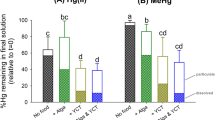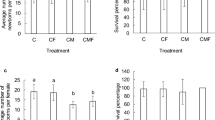Abstract
The presence of metals in aquatic environments has increased worldwide. Environmental assessments of metals in freshwater ecosystems presume that toxicity is mainly caused by aqueous exposure, but dietborne exposure (contaminated food) in zooplankton may occur because microalgae carry metal ions through adsorption/absorption of dissolved metal species, resulting in toxic effects once ingested by the animals. However, official regulations for ecotoxicological assays in most countries do not consider the toxic effects caused by dietborne exposure. Here, we provide life history parameters and secondary production of Simocephalus serrulatus (Koch 1841) (Cladocera: Daphniidae) fed with cadmium (Cd) contaminated algae during a 21-day bioassay. The microalgae Chlorophyceae Scenedesmus quadricauda was exposed for 96 h to dissolved Cd concentrations of 0.03; 5.87; 12.27 and 22.27 µg Cd l−1 (equivalent to 1.6 × 10−10; 3.2 × 10−8; 6.7 × 10−8; 1.2 × 10−7 mol l−1) that resulted in algae internal Cd burdens of 0.004; 0.032; 0.270 and 0.280 pg Cd cell−1, respectively. Significant toxic effects on life history parameters of S. serrulatus were observed. Time of embryonic development, generation time and age at first reproduction (primipara) showed significant delay. Length at first reproduction, number of eggs and clutches produced per female, hatching percentage, body length, survival and feeding rates were significantly reduced. Secondary production, that is, accumulated biomass for growth and reproduction, decreased significantly with dietborne Cd concentrations. Our results emphasize that food can be an important source of metals to zooplankton in aquatic ecosystems. Environmental regulations should consider the diet in ecotoxicological assessments. Furthermore, secondary production may be considered as a suitable endpoint in ecotoxicity tests.





Similar content being viewed by others
References
Amiard JC, Amiard-Trquet C, Barka S, Pellerin J, Rainbow PS (2006) Metallothioneins in aquatic invertebrates: their role in metal detoxification and their use as biomakers. Aquat Toxicol 76:160–202
Associação Brasileira de Normas Técnicas (ABNT) (2005) Avaliação da toxicidade crônica utilizando Ceriodaphnia spp., (Cladocera, Crustacea). NBR13373
Association Française Normalisation (AFNOR) (1980) Essais deseaux Determination de I’inhibition de Scenesdesmus subspicatus par une substance. Norme experimentale T90-304
Baillieul M, Smolders R, Blust R (2005) The effect of environmental stress on absolute and mass-specific scope for growth in Daphnia magna Strauss. Comp Biochem Physiol C 140:364–373
Barata C, Baird DJ (2000) Determining the ecotoxicological mode of action of chemicals from measurements made on individuals: results from instar-based tests with Daphnia magna Straus. Aquat Toxicol 48:195–209
Barata C, Markich SJ, Baird DJ, Soares AMVM (2002) The relative importance of water food as cadmium sources to Daphnia magna Straus. Aquat Toxicol 61:143–154
Barber I, Baird DJ, Calow P (1994) Effect of cadmium and ration level on oxygen consumption, RNA concentration and RNA-DNA ratio in two clones of Daphnia magna Straus. Aquat Toxicol 30:249–258
Bossuyt BTA, Janssen CR (2005) Copper toxicity to different field-collected cladoceran species: intra- and inter-species sensitivity. Environ Pollut 136:145–154
Bottrell HH, Duncan A, Gliwicz ZM, Grygierek E, Herzig A, Hillbricht-Ilkowska A, Kurasaua H, Larsson P, Weglenska T (1976) A review of some problems in zooplankton production studies. Norw J Zool 24:419–456
Conselho Nacional do Meio Ambiente (CONAMA) (2005). Resolução nº 357 de 17 de março. Ministério do Meio Ambiente http://www.mma.gov.br/pot/conama. Accessed June 2014
De Schamphelaere KAC, Forrez I, Dierckens K, Sorgeloos P, Janssen CR (2007) Chronic toxicity of dietary copper to Daphnia magna. Aquat Toxicol 81:409–418
Debelius B, Forja JM, DelValls A, Lubián LM (2009) Toxicity and bioaccumulation of copper and lead in five marine microalgae. Ecotoxicol Environ Saf 72:1503–1513
Downing JA, Rigler FH (1984) A manual of methods for the assessment of secondary productivity in freshwater. Blackwell Scientific, Oxford and Edinburgh, Oxford
Edmondson WT, Winberg GG (1971) A manual on methods for the assessment of secondary productivity in freshwaters. Blackwell Scientific, Oxford and Edinburgh, Oxford
El-Moor-Loureiro LMA (1997) Manual para a identificação dos Cladocera límnicos brasileiros. Universa: Universidade Católica de Brasília, Brasília
Emsley J (1998) The elements. Clarendon Press Oxford, London
Faupel M, Traunspurger W (2012) Secondary production of zoobenthic community under metal stress. Water Res 46:3345–3352
Faupel M, Ristau K, Traunspurger W (2011) Biomass estimation across the benthic community in polluted freshwater sediment: a promising endpoint in microcosm studies? Ecotoxicol Environ Saf 74:1942–1950
Faupel M, Ristau K, Traunspurger W (2012) The functional response of a freshwater benthic community to cadmium pollution. Environ Pollut 162:104–109
Gauld DT (1951) The grazing rate of planktonic copepods. J Mar Biol Assoc UK 29:695–705
Geffard O, Geffard A, Chaumot A, Vollat B, Alvarez C, Tusseau-Vuillemin MH, Garric J (2008) Effects of chronic dietary and waterborne cadmium exposures on the contamination level and reproduction of Daphnia magna. Environ Toxicol Chem 27:1128–1134
Goulet RR, Krack S, Doyle PJ, Hare L, Vigneault B, McGeer JC (2007) Dynamic multipathway modeling of Cd bioaccumulation in Daphnia magna using waterborne and dietborne exposure. Aquat Toxicol 81:117–125
Gusso-Choueri PK, Choueri RB, Lombardi AT, Melão MGG (2012) Effects of dietary cadmium on life-history traits of a tropical freshwater cladoceran. Arch Environ Contam Toxicol 62:589–598
Hickey CW (1989) Sensitivity of four New Zealand cladoceran species and Daphnia magna to aquatic toxicants. N Z J Mar Freshw Res 23:131–137
Hook SE, Fisher NS (2000) Exposure to silver via food reduces egg production and viability in herbivorous copepods and cladocerans. Mar Environ Res 50:545–552
Khoshmanesh A, Lawson F, Pince IG (1996) Cadmium uptake by unicellular green microalgae. The Chem Eng J 62:81–88
Knops M, Altenburger R, Seger H (2001) Alterations of physiological energetics, growth and reproduction of Daphnia magna under toxicant stress. Aquat Toxicol 53:79–90
Kooijman SALM (2000) Dynamic energy and mass budgets in biological systems. Cambridge University Press, Cambridge
Lombardi AT, Vieira AAH, Sartori LA (2002) Muscilaginous capsule adsorption and intracellular uptake of copper by Kircheriella aperta (Chlorococcales). J Phycol 38:332–337
Lores EM, Pennock JR (1999) Bioavailability and trophic transfer of humic-bound copper from bacteria to zooplankton. Mar Ecol Progr Ser 187:67–75
Munger C, Hare L, Craig A, Charest PM (1999) Influence of exposure time on the distribution of cadmium within the cladoceran Ceriodaphnia dubia. Aquat Toxicol 44:195–200
Muyssen BTA, Bossuyt BTA, Janssen CR (2005) Inter- and intra-species variation in acute zinc tolerance of field-collected cladoceran populations. Chemosphere 61:1159–1167
Nogueira AJA, Baird DJ, Soares AMVM (2004) Testing physiologically based resource allocation rules in laboratory experiments with Daphnia magna Straus. Ann Limnol Int J Limnol 40:257–267
Nogueira PFM, Melão MGG, Lombardi AT, Vieira AAH (2005) The effects of Anabaena spiroides (Cyanophyceae) exopolysaccharide on copper toxicity to Simocephalus serrulatus (Cladocera, Daphnidae). Freshw Biol 50:1560–1567
Organization for Economic Cooperation and Development (OECD) (1998) Test Guideline Nº. 211: Daphnia magna reproduction test. OECD 211
Organization for Economic Cooperation and Development (OECD) (2006) Guidelines for the testing of chemicals. Nº. 211: Freshwater Alga and Cyanobacteria. Growth Inhibition Test. OECD 211
Organization for Economic Cooperation and Development (OECD) (2007) Guidelines for the testing of chemicals. Nº. 225: Sediment-Water Lumbriculus Toxicity Test Using Spiked Sediment. OECD 225
Rodgher S, Espíndola ELG (2008) Effects of interactions between algal densities and cadmium concentrations on Ceriodaphnia dubia fecundity and survival. Ecotoxicol Environ Saf 71:765–773
Rodgher S, Lombardi AT, Melão MGG (2009) Evaluation onto life cycle parameters of Ceriodaphnia silvestrii submitted to 36 days dietary copper exposure. Ecotoxicol Environ Saf 72:1748–1753
Ruangsomboon S, Wongrat L (2006) Bioaccumulation of cadmium in an experimental aquatic food chain involving phytoplankton (Chlorella vulgaris), zooplankton (Moina macrocopa), and the predatory catfish Clarias macrocephalus × C. gariepinus. Aquat Toxicol 78:15–20
Smolders R, Baillieul M, Blust R (2005) Relationship between the energy status of Daphnia magna and its sensitivity to environmental stress. Aquat Toxicol 73:155–170
Sofyan A, Price DJ, Wesley JB (2007) Effects of aqueous, dietary and combined exposure of cadmium to Ceriodaphnia dubia. Sci Total Environ 385:108–116
Taylor G, Baird DJ, Soares AMVM (1998) Surface binding of contaminants by algae: consequences for lethal toxicity and feeding to Daphnia magna Straus. Environ Toxicol Chem 17:412–419
United States Environmental Protection Agency (USEPA) (1996) Ecological effects test guidelines. Daphinid Chronic Toxicity Test. EPA/OPPTS 850.1300/1996
Wang ZS, Kong HN, Wu DY (2009) Acute and chronic copper toxicity to a saltwater cladoceran Moina monogolica Daday. Arch Environ Contam Toxicol 53:50–56
Wang Z, Yan C, Hynez RV (2010) Effects of dietary cadmium exposure on reproduction of saltwater cladoceran Moina monogolica Daday: implications in Water Quality Criteria. Environ Toxicol Chem 29:365–372
Winberg GG (1971) Methods for the estimation of production of aquatic animals. Academic Press, Inc., London Ltd and New York
Acknowledgments
This work was supported by Fundação de Amparo à Pesquisa do Estado de São Paulo - FAPESP (Proc. No. 2008/03487-0; 2008/02078-9; 2008/05464-7) and Conselho Nacional de Desenvolvimento Científico e Tecnológico - CNPq (Proc. No. 305183/2008-7; 556588/2009-6). The authors thank Dr. Hugo Sarmento for your assistance in the paper review.
Conflict of interest
The authors declare that they have no conflict of interest.
Author information
Authors and Affiliations
Corresponding author
Rights and permissions
About this article
Cite this article
Souza, J.P., Melo, D.C., Lombardi, A.T. et al. Effects of dietborne cadmium on life history and secondary production of a tropical freshwater cladoceran. Ecotoxicology 23, 1764–1773 (2014). https://doi.org/10.1007/s10646-014-1341-4
Accepted:
Published:
Issue Date:
DOI: https://doi.org/10.1007/s10646-014-1341-4




